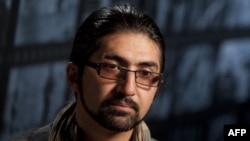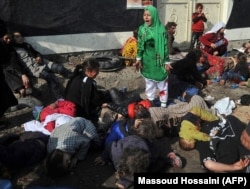Afghan photojournalist Massoud Hossaini, who has been working for the Associated Press in Kabul, said he survived what he called an assassination attempt Thursday.
Hossaini won the Pulitzer Prize for breaking news photography in 2012 after capturing the image of a crying girl in the aftermath of a suicide attack on a crowded Shi'ite shrine in Kabul.
He told VOA that three gunmen got out of a car Thursday and started shooting at his vehicle as he was driving his car.
"As I began driving, a Toyota car blocked my way and three people got out of the car with guns and started firing at my car. It took me a few seconds to make sense of the situation and realize that the target of the attackers was me," Hossaini said.
"As soon as I realized that I was the target, I rammed my vehicle into the car of the gunmen and fled the scene to a nearby police station," he added.
Hossaini said authorities were investigating the incident, and that while it was premature to blame any group, he did rule out the possibility of this being a criminal incident.
"I can tell you that this was not an armed robbery, as I had the key inside my vehicle when I left it to purchase a phone card, and they [armed men] could have gotten the car easily," he said.
Previous threats
Hossaini said he had received threats in the past from the Islamic State terror group and the Taliban.
"Just like other reporters, I also received a series of threats from the Islamic State and the Taliban, but I did not think such a thing would take place. Even now, I cannot speculate on who carried out the attack, as the investigation is underway to get to the bottom of the issue," he said.
Hossaini is the only Afghan who has won the prestigious Pulitzer Prize for breaking news photography for taking the photo of a 12-year-old girl, Tarana Akbari, who was standing in the middle of dead and injured bodies at the Abul Fazl shrine in Kabul in 2011.
She was screaming and trying to make sense of what had happened. The suicide attack killed more than 80 people and injured dozens more.
Hossaini was working for Agence France-Presse at the time and was inside the shrine to cover the Ashura event, a religious day commemorating the killing of Imam Hussain, the grandson of the Prophet Muhammad. The photo made headlines and went viral globally on social media.
The Afghan Taliban condemned the attack at the time and denied responsibility for it. Lashkar e-Jangvi, an armed group in Pakistan known for violence against Shiite Muslims, claimed responsibility for the attack. The 2011 terror attack on the shrine was the first major attack against the Shiite minority in Afghanistan.
Since then, Islamic State has claimed responsibility for a series of terror attacks against Shiite mosques and religious centers in different parts of Afghanistan, killing and injuring hundreds of people, mainly Shiites.
Sectarian war sought
IS has been trying to trigger a sectarian war between Shiite and Sunni Muslims inside Afghanistan.
Afghan officials claim that IS in Afghanistan is mostly made up of members of Lashkare-Taiba, Lashkar-e-Jhangvi and the Haqqani network, which all are based in Pakistan and just changed their names and affiliation.
All three militant groups are U.S.- and EU-designated terror organizations.
Hossaini also was trapped inside the American University of Afghanistan during a terror attack on the university in 2016, which killed 13 people and injured several others, including Hossaini.
The Afghanistan Journalists Center, a media advocacy group, condemned the attack on Hossaini and urged law enforcement authorities of the country to investigate the incident and share their findings with the media as to who was behind the attack.
VOA's Afghan Service contributed to this report.










